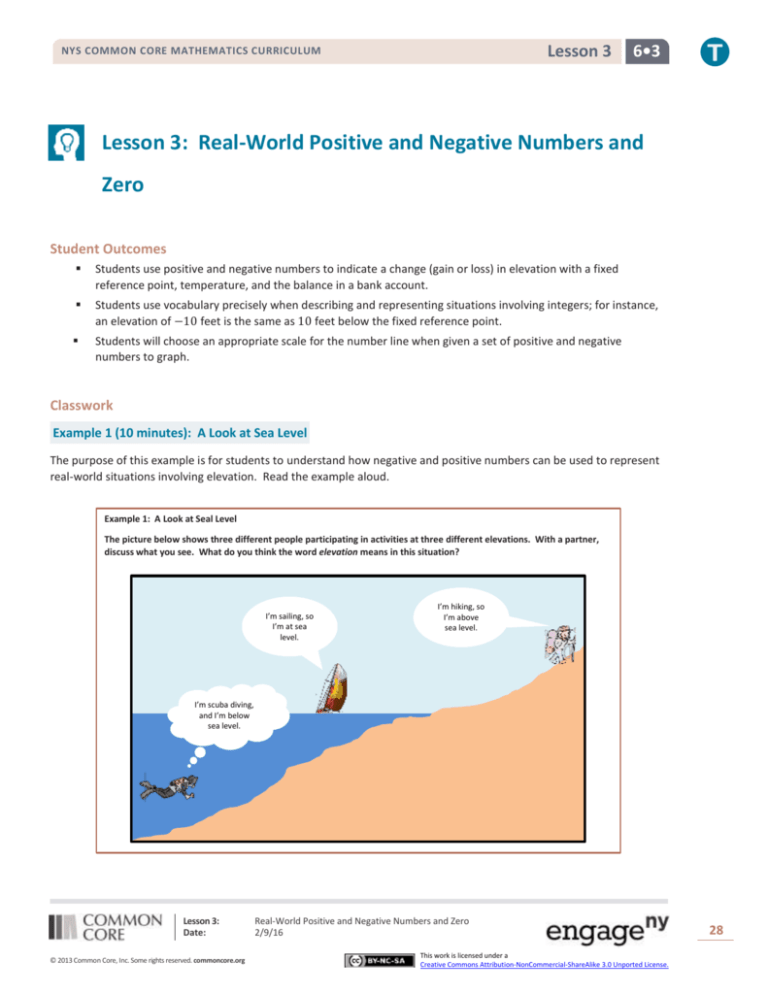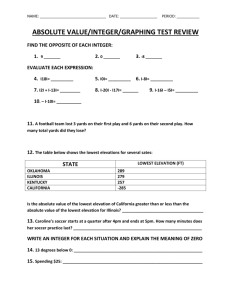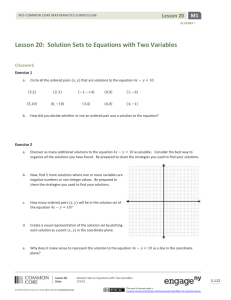
Lesson 3
NYS COMMON CORE MATHEMATICS CURRICULUM
6•3
Lesson 3: Real-World Positive and Negative Numbers and
Zero
Student Outcomes
Students use positive and negative numbers to indicate a change (gain or loss) in elevation with a fixed
reference point, temperature, and the balance in a bank account.
Students use vocabulary precisely when describing and representing situations involving integers; for instance,
an elevation of −10 feet is the same as 10 feet below the fixed reference point.
Students will choose an appropriate scale for the number line when given a set of positive and negative
numbers to graph.
Classwork
Example 1 (10 minutes): A Look at Sea Level
The purpose of this example is for students to understand how negative and positive numbers can be used to represent
real-world situations involving elevation. Read the example aloud.
Example 1: A Look at Seal Level
The picture below shows three different people participating in activities at three different elevations. With a partner,
discuss what you see. What do you think the word elevation means in this situation?
I’m sailing, so
I’m at sea
level.
I’m hiking, so
I’m above
sea level.
I’m scuba diving,
and I’m below
sea level.
Lesson 3:
Date:
© 2013 Common Core, Inc. Some rights reserved. commoncore.org
Real-World Positive and Negative Numbers and Zero
2/9/16
This work is licensed under a
Creative Commons Attribution-NonCommercial-ShareAlike 3.0 Unported License.
28
Lesson 3
NYS COMMON CORE MATHEMATICS CURRICULUM
6•3
Teacher should pose questions to the class and define elevation. Students will gain additional practice with elevation by
completing Exercise 1 independently.
Possible Discussion Questions:
Looking at the picture, if you were to draw a vertical number line to model elevation, which person’s elevation
do you think would be at zero? Explain.
Sea level should represent an elevation of zero. So, the person sailing would be at zero because they
are sailing on the surface of the water, which is neither above nor below the surface. On a number line,
zero is the point or number separating positive and negative numbers.
On the same vertical number line, which person’s elevation would be represented above zero?
The elevation of the person hiking would be above zero because she is moving higher above the water.
On a vertical number line, this is represented by a positive value above zero because she is above the
surface.
On the same vertical number line, which person’s elevation do you think would be below zero?
The elevation of the person diving would be below zero because he is swimming below the surface of
the water. On a vertical number line, this is represented by a negative value below zero because he is
below the surface.
What does zero represent in this situation?
Zero represents the top of the water (the water’s surface).
In this example, which numbers correspond to elevations above sea level?
Above sea level means to be above zero, which are positive numbers.
In this example, which numbers correspond to elevations below sea level?
Below sea level means to be below zero, which are negative numbers.
On a number line, what does it mean to be at sea level?
To be at zero.
Elevation is the height of a person, place, or thing above a certain reference point. In this case, what is the
reference point?
The reference point is sea level.
Exercises 1–3 (5 minutes)
Exercises
Refer back to Example 1. Use the following information to answer the questions.
1.
The diver is 𝟑𝟎 feet below sea level.
The sailor is at sea level.
The hiker is 𝟐 miles (𝟏𝟎, 𝟓𝟔𝟎 feet) above sea level.
Write an integer to represent each situation.
Diver : −𝟑𝟎
Sailor: 𝟎
Hiker: 𝟐 miles or 𝟏𝟎, 𝟓𝟔𝟎 feet
Lesson 3:
Date:
© 2013 Common Core, Inc. Some rights reserved. commoncore.org
Real-World Positive and Negative Numbers and Zero
2/9/16
This work is licensed under a
Creative Commons Attribution-NonCommercial-ShareAlike 3.0 Unported License.
29
Lesson 3
NYS COMMON CORE MATHEMATICS CURRICULUM
2.
Use an appropriate scale to graph each of the following situations on the number line to the right.
Also, write an integer to represent both situations.
a.
A hiker is 𝟏𝟓 feet above sea level.
6•3
𝟐𝟎
𝟏𝟓
𝟏𝟓
𝟏𝟎
𝟓
b.
A diver is 𝟐𝟎 feet below sea level.
𝟎
−𝟐𝟎
−𝟓
−𝟏𝟎
−𝟏𝟓
−𝟐𝟎
Students should identify common misconceptions of how to represent an answer, based on the phrasing of a question.
Students will practice this skill in Exercise 3.
How many feet below sea level is the diver?
MP.6
Students should answer using a positive number, such as 70 feet, because “below” already indicates
that the number is negative.
Which integer would represent 50 feet below sea level?
3.
Students should answer by saying “−50” and not”−50 below sea level.”
For each statement there are two related statements: i and ii. Determine which related statement is expressed
correctly (i and ii), and circle it. Then correct the other related statement so that both parts, i and ii, are stated
correctly.
a.
A submarine is submerged 𝟖𝟎𝟎 feet below sea level.
i.
The depth of the submarine is −𝟖𝟎𝟎 feet below sea level.
The depth of the submarine is 𝟖𝟎𝟎 feet below sea level.
ii.
b.
𝟖𝟎𝟎 feet below sea level can be represented by the integer −𝟖𝟎𝟎.
The elevation of a coral reef with respect to sea level is given as −𝟐𝟓𝟎 feet.
i.
The coral reef is 𝟐𝟓𝟎 feet below sea level.
ii.
The depth of the coral reef is −𝟐𝟓𝟎 feet below sea level.
The depth of the coral reef is 𝟐𝟓𝟎 feet below sea level.
Lesson 3:
Date:
© 2013 Common Core, Inc. Some rights reserved. commoncore.org
Real-World Positive and Negative Numbers and Zero
2/9/16
This work is licensed under a
Creative Commons Attribution-NonCommercial-ShareAlike 3.0 Unported License.
30
Lesson 3
NYS COMMON CORE MATHEMATICS CURRICULUM
6•3
Exploratory Challenge (20 minutes)
Materials:
Copies (one per student) of the Challenge Exploration Station Record Sheet (See attached template.)
Sheets of loose-leaf paper (one per group) for the answer key for their poster
Rulers or Meter Stick or Yard Stick (one per group)
Construction Paper or Wall-sized Grid Paper (1 sheet for each group)
Markers (one set or a few for each group)
Students will work in groups of 3–4 to create their own real world situations involving
money, temperature, elevation and other real world scenarios. The teacher gives each
group a sheet of wall-sized grid-paper (or construction paper) numbered one to five,
markers, and a ruler. Using these materials, each group will present its situation on the
paper by including the components in the bulleted list below. Allow students 10 minutes
to create their posters and hang them on a wall in the room.
Title (e.g., Sea Level, Temperature)
A written situation based on the title (using at least two points)
A blank vertical number line
Picture (optional if time permits)
Answer key (on a separate sheet of paper stapled to the top back right corner)
Scaffolding:
Allow groups to present
their posters to the class,
and the class will answer
the questions during the
presentation.
Groups will rotate every 5 minutes to complete the three tasks on the Station Record sheet of paper while viewing each
poster.
Write the integer for each situation.
Determine the appropriate scale to graph the points.
Graph the point on the number line.
Closing (3 minutes)
How did we record measures of elevation on a number line?
Elevations above sea level are positive numbers, and they are above 𝑧𝑒𝑟𝑜. Elevations below sea level
are negative numbers, and they are below 𝑧𝑒𝑟𝑜.
Is “−90 feet below sea level” an appropriate answer to a question? Why or why not?
No. You do not need the negative sign to write 90 feet below zero because the word “below” in this
case means a negative number.
Exit Ticket (7 minutes)
Lesson 3:
Date:
© 2013 Common Core, Inc. Some rights reserved. commoncore.org
Real-World Positive and Negative Numbers and Zero
2/9/16
This work is licensed under a
Creative Commons Attribution-NonCommercial-ShareAlike 3.0 Unported License.
31
Lesson 3
NYS COMMON CORE MATHEMATICS CURRICULUM
Name ___________________________________________________
6•3
Date____________________
Lesson 3: Real-World Positive and Negative Numbers and Zero
Exit Ticket
1.
Write a story problem using sea level that includes both integers −110 and 120.
2.
What does zero represent in your story problem?
3.
Choose an appropriate scale to graph both integers on the vertical number line.
4.
Graph and label both points on the vertical number line.
Lesson 3:
Date:
© 2013 Common Core, Inc. Some rights reserved. commoncore.org
Real-World Positive and Negative Numbers and Zero
2/9/16
This work is licensed under a
Creative Commons Attribution-NonCommercial-ShareAlike 3.0 Unported License.
32
Lesson 3
NYS COMMON CORE MATHEMATICS CURRICULUM
6•3
Exit Ticket Sample Solutions
1.
Write a story problem using sea level that includes both integers −𝟏𝟏𝟎 and 𝟏𝟐𝟎.
(Answers may vary.) On the beach, a man’s kite flies at 𝟏𝟐𝟎 feet above the water’s surface. In
the ocean, a white shark swims at 𝟏𝟏𝟎 feet below the water’s surface.
2.
𝟏𝟐𝟎
What does zero represent in your story problem?
Zero represents the water’s surface level.
3.
Choose and label an appropriate scale to graph both integers on the vertical number line.
𝟎
I chose a scale of 𝟏𝟎.
4.
Graph and label both points on the vertical number line
−𝟏𝟏𝟎
Problem Set Sample Solutions
1.
Write an integer to match the following descriptions:
a.
A debit of $𝟒𝟎
b.
A deposit of $𝟐𝟐𝟓
c.
𝟏𝟒, 𝟎𝟎𝟎 feet above sea level
d.
A temperature increase of 𝟒𝟎 degrees
e.
A withdrawal of $𝟐𝟐𝟓
f.
𝟏𝟒, 𝟎𝟎𝟎 feet below sea level
−𝟒𝟎
𝟐𝟐𝟓
𝟏𝟒, 𝟎𝟎𝟎
𝟒𝟎
−𝟐𝟐𝟓
−𝟏𝟒, 𝟎𝟎𝟎
For questions 2–4, read each statement about a real-world situation and the two related statements in parts (a) and (b)
carefully. Circle the correct way to describe each real-world situation; possible answers include either (a), (b), or both (a)
and (b).
2.
A whale is 𝟔𝟎𝟎 feet below the surface of the ocean water.
a.
The depth of the whale is 𝟔𝟎𝟎 feet from the water’s surface.
b.
The whale is −𝟔𝟎𝟎 feet below the surface of the ocean water.
Lesson 3:
Date:
© 2013 Common Core, Inc. Some rights reserved. commoncore.org
Real-World Positive and Negative Numbers and Zero
2/9/16
This work is licensed under a
Creative Commons Attribution-NonCommercial-ShareAlike 3.0 Unported License.
33
Lesson 3
NYS COMMON CORE MATHEMATICS CURRICULUM
3.
4.
5.
6•3
The elevation of an iceberg with respect to sea level is given as −𝟏𝟐𝟓 feet.
a.
The iceberg is 𝟏𝟐𝟓 above sea level.
b.
The iceberg is 𝟏𝟐𝟓 feet below sea level.
Alex’s body temperature decreased by 𝟐°𝑭.
a.
Alex’s body temperature dropped 𝟐°𝑭.
b.
The integer −𝟐 represents the change in Alex’s body temperature in degrees Fahrenheit.
A credit of $𝟑𝟓 and a debit of $𝟒𝟎 are applied to your bank account.
a.
What is an appropriate scale to graph a credit of $𝟑𝟓 and a debit of $𝟒𝟎? Explain your reasoning.
I would count by 𝟓’𝒔 because both numbers are multiples of 𝟓.
b.
What integer represents “a credit of $𝟑𝟓” if zero represents the original balance? Explain.
𝟑𝟓; a credit is greater than zero, and numbers greater than zero are positive numbers.
c.
What integer describes “debit of $𝟒𝟎” if zero represents the original balance? Explain.
−𝟒𝟎; a debit is less than zero, and numbers less than 𝒛𝒆𝒓𝒐 are negative numbers.
d.
Based on your scale, describe the location of both integers on the number line.
𝟑𝟓 would be 𝟕 units to the right of zero, and −𝟒𝟎 would be 𝟖 units to the left of zero.
e.
What does zero represent in this situation?
Zero represents no change being made to the account balance. In other words, no amount is either
subtracted or added to the account.
Lesson 3:
Date:
© 2013 Common Core, Inc. Some rights reserved. commoncore.org
Real-World Positive and Negative Numbers and Zero
2/9/16
This work is licensed under a
Creative Commons Attribution-NonCommercial-ShareAlike 3.0 Unported License.
34
Lesson 3
NYS COMMON CORE MATHEMATICS CURRICULUM
Name ___________________________________________________
6•3
Date____________________
Exploratory Challenge Station Record Sheet
Poster # _______
Integer(s): ___________________
#1
#2
#3
#4
#5
Number Line Scale ________
Poster # _______
Integer(s): ___________________
Number Line Scale ________
Poster # _______
Integer(s): ___________________
Number Line Scale ________
Poster # _______
Integer(s): ___________________
Number Line Scale ________
Poster # _______
Integer(s): ___________________
Number Line Scale ________
Lesson 3:
Date:
© 2013 Common Core, Inc. Some rights reserved. commoncore.org
Real-World Positive and Negative Numbers and Zero
2/9/16
This work is licensed under a
Creative Commons Attribution-NonCommercial-ShareAlike 3.0 Unported License.
35









